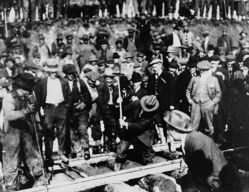Grand Trunk Pacific Railway
| Grand Trunk Pacific Railway | |
|---|---|
| logo | |
| Locale | Ontario, Manitoba, Saskatchewan, Alberta, British Columbia |
| Dates of operation | 1914 – 1920 |
| Track gauge | 4 ft 8½ in (1435 mm) (standard gauge) |
| Headquarters | |
The Grand Trunk Pacific Railway (GTPR) was a historical Canadian railway.
A wholly owned subsidiary of the Grand Trunk Railway (GTR), the GTPR was constructed by GTR using loans provided by the Government of Canada. The company was formed in 1903 with a mandate to build west from Winnipeg, Manitoba to the Pacific coast at Prince Rupert, British Columbia. East of Winnipeg, the federal government would build the National Transcontinental Railway (NTR) across Northern Ontario and Quebec, crossing the St. Lawrence River at Quebec City and ending at Moncton, New Brunswick. The conceptual plan was to have GTR operate both GTPR and NTR as a single transcontinental railway, competing with the Canadian Northern Railway (CNoR) and Canadian Pacific Railway (CPR).
Turning of the first sod for the construction of the GTPR, took place at an official ceremony, September 11, 1905 at Fort William, Ontario, by Prime Minister Wilfrid Laurier. From there a 190 mile section of track was built by the Grand Trunk Pacific Construction Company, connecting with the NTR, near Sioux Lookout.
Construction began on the Canadian Prairies in 1905, the year that the provinces of Alberta and Saskatchewan were established. Construction proceeded west to Saskatoon, Saskatchewan in 1907, Edmonton, Alberta in 1909, and through Jasper, Alberta into Yellowhead Pass crossing the Continental Divide in 1910-1911. The last spike ceremony heralding completion of the rail line across the prairies, and through the Rocky Mountains to the newly constructed seaport at Prince Rupert, British Columbia was held one mile east of Fort Fraser, British Columbia on April 7, 1914.
The GTPR did not immediately realize the traffic potential GTR and the federal government had hoped. CPR occupied the more populous southern route in the prairies through Regina, Saskatchewan and Calgary, Alberta to Vancouver, British Columbia and was using land grants provided by the federal government as well as government incentives to draw immigrants and businesses to settle along its route. GTR did not have a coordinated marketing plan, and efforts at settlement were disrupted by the First World War. GTR rejected operating the NTR for cost reasons, forcing the federal government to assume that operation into Canadian Government Railways.
By 1919 it was obvious that the GTPR was not paying its way. The financial strain broke on March 7 when GTR defaulted on repayment of construction loans to the federal government, whereby the GTPR was nationalized and taken over by a Board of Management operating under the Department of Railways and Canals while legalities were resolved. On July 12, 1920 the GTPR was placed under the management of Crown corporation Canadian National Railways (CNR) and in 1923 was completely absorbed into the CNR.
Today, the majority of the GTPR is still in use as CN's (name change to Canadian National or acronym CN in 1960) main line from Winnipeg to Jasper. West of Jasper, CN's main line swings south on the former Canadian Northern Railway (CNoR) to Vancouver, however the GTPR line to Prince Rupert forms an important CN secondary main line. The GTPR's high construction standards and the fact Yellowhead Pass has the lowest elevation of any railway crossing of the Continental Divide in North America gives the CN a competitive advantage in terms of fuel efficiency and the ability to haul tonnage.
Prince Rupert is the primary marine-railway connection for the Alaska Railroad, and despite having languished as a poor cousin to the Port of Vancouver, there are many opportunities for this port city as a result of the GTPR's foresight a century ago.

